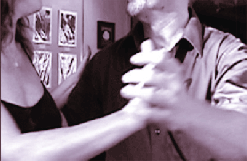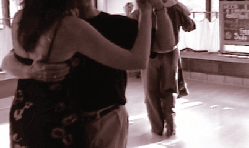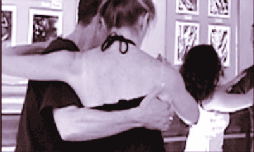
HOME
PUBLISHER’S CORNER
“A SENSORY BRIDGE TO GLOBAL CULTURE”


Advertise in:

AS WE INAUGURATE
TANGO LIFE & NEWS
TAKE ADVANTAGE OF OUR EXCLUSIVE
ONE-TIME OFFER TO PLACE YOUR AD HERE
FREE DURING NOVEMBER!
ADVERTISERS, DON’T MISS THIS CHANCE TO FEATURE
YOUR BUSINESS IN PREMIUM WEB SPACE
THAT WILL BE SEEN BY A GLOBAL AUDIENCE!
FOR DETAILS.
312.287.8406
AS A SPECIAL INTRODUCTORY BONUS, YOU’LL ALSO RECEIVE A DISCOUNT ON ADS PLACED THROUGH JANUARY 6, 2011.

THE S P A C E BETWEEN US
PSYCHOLOGICAL PERSPECTIVES ON THE DANCE OF RELATIONSHIP

THE S P A C E
BETWEEN US
CONTINUES...CLICK HERE
CONTINUED
S P A C E AND
EMOTIONS BETWEEN US
The goal of Argentine tango lies not in performing or mastering steps, but instead in mastering the relationship between the partners and in the vital expression of emotion.
Depth of emotion is essential in Argentine tango, so much so that there is a saying that “you must have suffered in life to dance the tango.”2 Juan Carlos Copes, one of the most well-known tango dancers in the world, summed up the relational aspect well when he said, “Sometimes there is confusion that the tango is the steps. No. Tango is the feeling. It is one heart and four legs.”3 Chan Park, author of Tango Zen, adds that “unlike other social dances danced by a couple, Tango is characterized as a dance of improvisation based on mutual communication between two partners moving as one.”4
Although leaders are traditionally men and followers are traditionally women, it is acceptable for men and women to learn and dance both. In The Temptation to Tango, author Irene Thomas simply and eloquently states the responsibility of the leader as “leading with confidence and sensitivity” and the follower’s as “following with sensitivity and confidence.” She describes the exchange between the two as such: “The leader’s intention is a kind of persuasive argument he presents to his partner, and for which he awaits a response.” The tango is entirely comprised of a series of these exchanges.
Aside from those basic guidelines and a few basic steps, the rest is largely based on improvisation. Many teachers offer sequenced steps in order to teach something more concrete and tangible to beginners and to supply leaders with patterns upon which they can build the dance. While this helps dancers feel a quicker sense of mastery, it leaves less room for improvisation, which is the true soul of the dance. Fundamentals of lead and follow, connection and balance are subtle and ironically much more challenging than practicing advanced figures.5
What brings people to the tango in the first place and what fuels the pursuit? Irene Thomas claims in her book, The Temptation to Tango: Journeys of Intimacy and Desire, that the expression of emotion and longing for sexual union underlie tango’s magnetic pull.6 David Turner, author of A Passion for Tango, agrees that people come to tango seeking to intimately connect with others within a safe environment.7 Laurie Hawkes, a transactional analyst who has run tango therapy workshops, found that many women described feeling euphoric after a well attuned dance, much like the sensation of being in love. Although less men report this same feeling, they do describe feeling a sense of “magic.”
“No one ever invokes the image of tango to describe the dull and sedate,” writes Thomas. Tango whisks one away from the mundane and into a world of romance and glamour. The dance transforms, in that one not need be physically young or beautiful to be beautiful while dancing the tango. Some elderly tangueros will say that dancing tango feels like cheating death, the author states.
ARRIVAL AT ONE’S TANGO DESTINY


This speaks loudly to the vitalizing effects of this intimate dance. It is supported by findings of a research project studying ballroom dance as therapy for the elderly in Brazil, where the participants reported that partner dancing allowed them to transcend “their physical, intellectual, and emotional limitations, as well as the conventional roles of the elderly in Brazilian society.”8
Others claim the tango is a spiritual pursuit. Argentine tango requires the couple to surrender to one another, to the music, to other dancers on the dance floor, and to the possibility of experience within the dance. Aided by deep breathing, tango dancers strive for inner and outer stillness.9
Chan Park likened tango fundamentals to practicing Zen meditation. Some of the parallels he made between the two included: dancing in the here and now; letting go of attachments and judgments that arise during the dance; releasing the ego in order to drop anticipation; adopting a beginner’s mind to be open for new experiences and wisdom; experiencing oneness of the universe through tango partnership; moving with confidence by dropping self-consciousness; and expressing our Buddha nature – the true nature of our Self – through tango dance.10
Many tango dancers have come to discover that universal truths are revealed through the dance and find that practice is a source of spiritual embodiment.
Women love the “abandon” they experience ― a chance for women leading powerful professional lives to surrender and explore their more feminine qualities. In the same way, men may be drawn to practicing their assertiveness and connecting to their masculinity.11
Johanna Siegmann, author of The Tao of Tango, found that tango allowed her to embody the lessons of male/female and yin/yang energies and connected the dance to the Chinese philosophy of Tao. She described herself as a woman full of masculine energy traits – independent, outgoing, and aggressive – who had plenty of resistance towards the idea of being a follower, a concept that seemed synonymous with weakness.
On the contrary, what Siegmann found instead while dancing tango was this seeming contradiction:
“For the first time in my life, I felt supremely feminine yet awesomely powerful, feelings that until that moment I had never experienced simultaneously…I actually experienced the intense joy of being a woman and never once felt the need to apologize for it.”12
Explaining how our society has aided in disconnecting both men and women from their male and female energies she states, “Tango empowered me in a way that I have rarely felt.”
As overcompensation for female oppression and in attempt to function in a “man’s world,” many women have adopted male traits to the exclusion of their female qualities.
“I HAVE NEVER DONE ANYTHING WHERE I’VE FELT SO EMOTIONALLY EXPOSED.”
̶ JULIE TAYLOR

